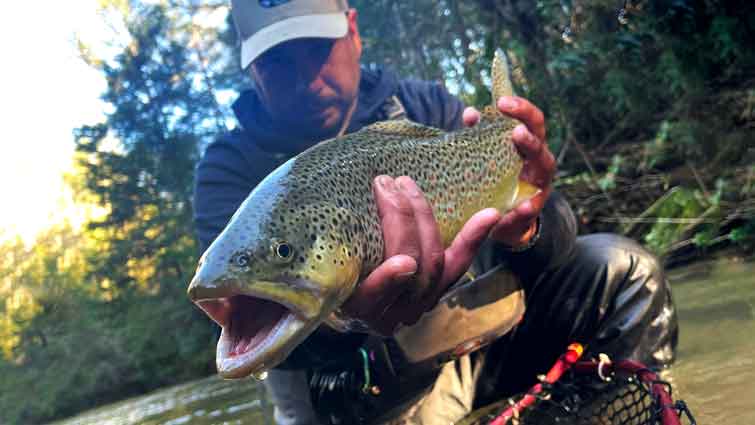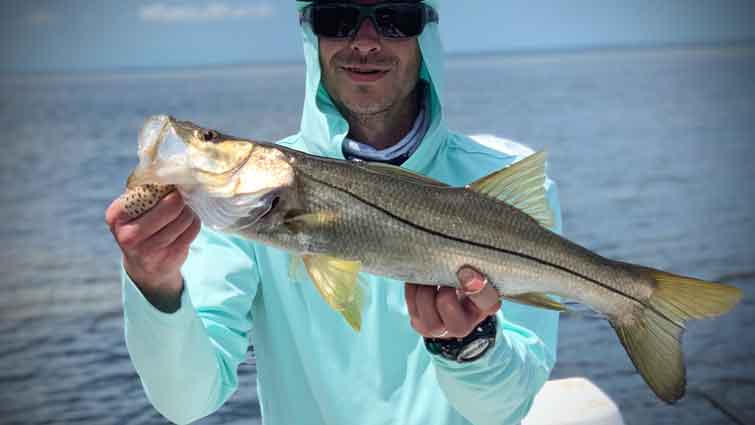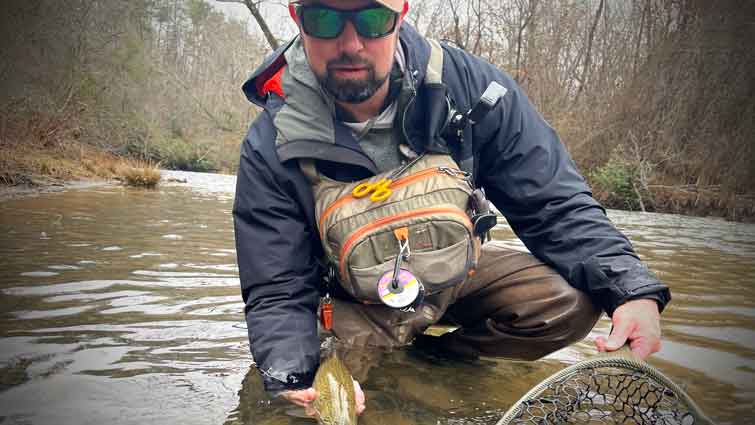What are the Best Waders for Fishing?
Waders may seem like an extravagant fly fishing gear purchase when plenty of anglers fish without them, but the benefits of waders far outweigh the price tag. It gives you better access and vantage point, but it makes it less likely that your cast will be obstructed by the trees and brush you encounter on the shore.

Waders also protect you from the potential dangers of standing in the water for extended periods—risks like trench foot which could lead to gangrene and even amputation.
The best waders for fishing are comfortable, warm, and keep you dry. They should be appropriately sized and belted for safety, and they should also be footed and provide sufficient traction for wading, especially in waters with algae or moss.
While there are other factors to consider in choosing a wader, any you purchase should be equipped to at least cover these basics. Let's get into more specifics on what you will need to look for in a wader to determine if it is the best for you.

Features to Look for in Waders for Fly Fishing
Choosing a wader, especially for the first time, can seem like a daunting task with the amount of product out there. You not only have to think about which brands provide quality products, but you also want to consider the different types of waders and which features best suit your needs. The features you gravitate toward will be dependent on the kind of fishing you do, the locations you frequent, and the risks you're willing to take to hook a fish.
Consider your preferences before researching the products out there; that way, you aren't overwhelmed with the choices. Ask yourself what kind of terrain you're dealing with in the locations you frequent.
Think about the levels of these bodies of water and how high they can go at any given time of the year, especially during or right after the rainy season. Assess how your body handles extreme temperatures, so you will know how warm your wader will need to be to remain comfortable.

Once you've evaluated these elements, you can start to look at the features of waders and narrow down your selection. Each of these factors will be a deciding factor in the wader you end up with:
- Size
- Cut/Style
- Materials
- Stockingfoot vs. Bootfoot
In terms of size, it would be best to take your measurements before shopping around for your wader. Typically there is a range that may fit into one sizing, and because everyone's frame is unique and there is no such thing as one size fits all, it would benefit you to know beforehand. Areas of importance are hips, waist, overall length (inseam), and chest.

Size
As stated before, taking your measurements is essential when looking for your waders, especially if you are online shopping. The sizings previously mentioned are the ones you will see displayed on websites. It will save you the hassle of returning a wader and waiting for a new one to arrive.
Keep in mind that retailers are in the business of catering to the masses, so they are going to cover the most common range of sizes. Your wader will not be custom-fitted, but if you're lucky, you can get close. Think about what is most important to you if you have to compromise on the fit.
If you're going to go with significant retailer options, you may have to make some accommodations. You may have a precise length-wise wader with a little more give in the hips than you prefer. On the flip side, you could have a wader that perfectly fits your hips and waist but comes just shy of covering your chest.

Cut/Style
There are two primary types of waders in terms of cut/style, and they fulfill different needs. The traditional style of wader is called the "chest wader," and as it states in its name, it comes up the chest, is higher in the center of the back, and cuts under the arms. It's held up by a pair of attached suspenders that can be adjustable. This cut/style of water is suitable for deeper waters and colder temperatures.
The other cut/style of waders are wading pants or waist waders. These are, in essence, waterproof pants with a belt at the waist. The belt is crucial to this cut/style for safety reasons. Without this piece, the waders can pose a drowning risk with their potential of taking on water and weighing you down.
Waist waders are ideal for shallow water and warmer temperatures, as they are designed to keep you cool. Some anglers go with the chest wader as their only pair because it's more easily transferable to different bodies of water and temperatures. However, you could have both in your inventory with more affordable options for each cut/style.
Materials
There are a variety of materials used in waders that range in durability, waterproof quality, price, temperature control, and breathability. Traditional waders were made of waterproof rubber that offered little breathability, and these waders are less common today than more suitable options.

One of the most common materials for waders is neoprene which is designed for colder temperatures. Think of a material similar to a wetsuit, but neoprene waders are entirely waterproof, unlike wetsuits. What they do have in common is their lack of breathability. You do not want to wear a neoprene wader in warmer weather; otherwise, you risk overheating.

Another common material is Gore-Tex, which is on the high end of the price range. This trademarked wader, like eVent, is designed with the highest technology to be both breathable and fully waterproof—the best of both worlds with the price tag to match.
On the lower end of the price range, you can go with a wader that consists of multiple layers of fabric treated with a waterproof coating. An example of this material would be nylon or polyester, breathable but not waterproof on its own. Another material would be canvas, but it is not as commonly found.

Stockingfoot vs. Bootfoot
The debate of stockingfoot vs. bootfoot comes down to affordability vs. convenience. While bootfoot is more common on the affordable side, it can be more challenging to find all the features and the correct sizing for both the wader and the attached boot. Difficult but not impossible, so many anglers go with this option.
Stockingfoot does not provide the all-in-one, so you will have to make a separate purchase for your boot to go over your stocking. Making two purchases could run up the cost of equipment, but it will provide you with a greater range of options that might be more suitable to your needs.

Frequently Asked Questions about Waders
Here are some of the most commonly asked questions about waders, boots, and their detailed responses.
How Do You Pick Fishing Waders?
To a lot of anglers, especially fly fishers, waders are an essential piece of equipment that should provide comfort, warmth, durability, ease of movement, and protection from the elements. If you've been fishing without waders or are taking up fishing for the first time, you may not know what to look for when purchasing fishing waders.
The best way to pick fishing waters is by first assessing your individual needs. Consider your style of fishing, location, body chemistry, and finances. If you tend to fish in deeper waters at colder temperatures, you'll want to consider chest waders. If you live in warmer temperatures and need to be kept cool, you'll want to look at breathable materials like nylon or polyester for a more affordable option or Gore-Tex for the higher-end price tag.
Once you know your preferences, you can look at elements like size, materials, cut/style, and footing to determine what best suits you.

What are the Most Durable Breathable Waders?
If you're practically a full-time angler or like to travel to different locations with varying environments, your needs for a good wader may be a bit more complex. It would be best to have a wader that can keep up with your lifestyle and ever-changing habitats-A wader that is both waterproof and breathable and long-lasting.
The most durable breathable waders contain a mixture of waterproof materials, like polyurethane and ePTFE; and breathable waders, like nylon and polyester. There are several waders like this on the market, but they may come with a heftier price tag than waders made of rubber, neoprene, or canvas.
How Do I Choose the Right Size Waders?
Retailers of fishing equipment, like waders, have to cater to the general public with their products. Therefore, when it comes to sizing, you tend to find sizes that cover a range of measurements. In an ideal world, every garment would be custom-fitted, but in the world of mass production, the objective is to get the closest fit to custom.
Choosing the right size wader is to take your measurement beforehand. The areas that you will commonly find on retailer websites or in-store are chest, waist, hips, and overall length (Inseam). After that, compare your numbers with ones online or in-store and decide on one that fits the closest to your measurements.
Are PVC Waders Any Good?
The age-old debate of which wader is the best and why is based mainly on personal preference mixed in with a bit of industry know-how. What is defined as good is based on the purpose of the product and the needs of the individual using it.
PVC waders are excellent when it comes to waterproofing. Made with layers of non-porous set material, PVC does not contain micro pores to allow any moisture to get through, including sweat, water, vapor, or other fragments. With that being said, PVC is not very breathable, presenting its challenges in warmer temperatures.
What Are the Warmest Waders?
Depending on the bodies of water you typically frequent, you may have different needs in the waders you purchase. If you are from a northern state, you will need waders designed for varying weather, including frigid temperatures. If you live in Florida or Texas and keep to your location when fishing, you will likely need waders designed for warmer temperatures.
Most anglers agree that the warmest waders are made of neoprene. While not very breathable, this material is thick and more insulated than other common materials on the market. Neoprene is waterproof, and keeping cold water out ensures that the body remains warm in chilly weather.

How Long Do Neoprene Waders Last?
The longevity of a product depends not only on the durability of the material but also on the care it's given by the owner. When dealing with a product like waders, you are also dealing with the wear and tear of the elements. The bodies of water you frequent and the environment you're in while fishing will affect the longevity of your wader.
One of the many benefits of neoprene is that the material is built to last. On average, neoprene waders should last an angler 15+ years. As a comparison, PVC waders last on average 3-4 seasons with moderate use and are well-maintained.
Do You Need Wading Boots?
Waders come in two primary cut/styles, stockfoot or bootfoot. For some anglers, the benefit of stockfoot is that it allows more versatility with equipment. For others, the convenience of the all-in-one bootfoot is a more considerable appeal.
You only need wading boots if your wader is stockfoot. The bootfoot wader comes with a wading boot attached, so you will not need to buy the boot separately. Stockfoot gives you the option of selecting from various styles and sizes of wading boots.

Do You Wear Boots Over Waders?
Like the previous question, you have two main cuts/styles of waders on the market: stockfoot and bootfoot. Each one will provide you with a different answer based on its varying features.
If you have a stockfoot wader, you will need to wear boots over your waders. If you have bootfoot waders, you will not need to wear boots over your waders because the boot comes attached.
Are Waders Necessary for Fly Fishing?
You may get different answers to this question depending on who you speak to. The equipment you will need for your beloved pastime depends on how you want to fish and what you are willing to invest in for fly fishing. For some, waders are non-negotiable.
Waders are not necessary for fly fishing. While waders benefit from the activity, there are certainly ways to fly fish without them. Sticking to the shore or bank is a prime example of engaging in the sport without waders. Staying out of the water will require you to use a different casting technique than those wading in the waters, but it can be as successful.

The best wader to purchase is the one that suits your individual needs and preferences. Considering their features, surroundings, and what you are willing to invest will help you narrow down the options to the perfect fit for you.





